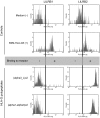Synthetic HLA-G proteins for therapeutic use in transplantation
- PMID: 23752205
- PMCID: PMC3752534
- DOI: 10.1096/fj.13-228247
Synthetic HLA-G proteins for therapeutic use in transplantation
Abstract
The human leukocyte antigen (HLA)-G is a tolerogenic molecule, whose expression by allografts is associated with better acceptance. An increasing interest in producing HLA-G as a clinical-grade molecule for therapy use is impaired by its complexity and limited stability. Our purpose was to engineer simpler and more stable HLA-G-derived molecules than the full-length HLA-G trimolecular complex that are also tolerogenic, functional as soluble molecules, and compatible with good manufacturing practice (GMP) production conditions. We present two synthetic molecules: (α3-L)x2 and (α1-α3)x2 polypeptides. We show their capability to bind the HLA-G receptor LILRB2 and their functions in vitro and in vivo. The (α1-α3)x2 polypeptide proved to be a potent tolerogenic molecule in vivo: One treatment of skin allograft recipient mice with (α1-α3)x2 was sufficient to significantly prolong graft survival, and four weekly treatments induced complete tolerance. Furthermore, (α1-α3)x2 was active as a soluble molecule and capable of inhibiting the proliferation of tumor cell lines, as does the full length HLA-G trimolecular complex. Thus, the synthetic (α1-α3)x2 polypeptide is a stable and simpler alternative to the full-length HLA-G molecule. It can be produced under GMP conditions, it functions as a soluble molecule, and it is at least as tolerogenic as HLA-G in vivo.
Keywords: engineered molecules; immune regulation; therapy; tolerance.
Figures




References
-
- Kovats S., Main E. K., Librach C., Stubblebine M., Fisher S. J., DeMars R. (1990) A class I antigen, HLA-G, expressed in human trophoblasts. Science 248, 220–223 - PubMed
-
- Mallet V., Blaschitz A., Crisa L., Schmitt C., Fournel S., King A., Loke Y. W., Dohr G., Le Bouteiller P. (1999) HLA-G in the human thymus: a subpopulation of medullary epithelial but not CD83(+) dendritic cells expresses HLA-G as a membrane-bound and soluble protein. Int. Immunol. 11, 889–898 - PubMed
-
- Cirulli V., Zalatan J., McMaster M., Prinsen R., Salomon D. R., Ricordi C., Torbett B. E., Meda P., Crisa L. (2006) The class I HLA repertoire of pancreatic islets comprises the nonclassical class Ib antigen HLA-G. Diabetes 55, 1214–1222 - PubMed
-
- Selmani Z., Naji A., Zidi I., Favier B., Gaiffe E., Obert L., Borg C., Saas P., Tiberghien P., Rouas-Freiss N., Carosella E. D., Deschaseaux F. (2008) Human leukocyte antigen-G5 secretion by human mesenchymal stem cells is required to suppress T lymphocyte and natural killer function and to induce CD4+CD25highFOXP3+ regulatory T cells. Stem Cells 26, 212–222 - PubMed
Publication types
MeSH terms
Substances
Grants and funding
LinkOut - more resources
Full Text Sources
Other Literature Sources
Research Materials

